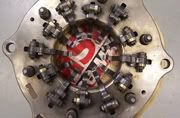FC138fan
Nitro Member


Hearing talk about how the clutch works in another thread reminded me that I never did put together how those things work.
I am an engineer, so I think I am pretty good at figuring out how things work. Now everything in front of the bell housing makes sence - its the 4 cycle engine (a hopped up version for sure, but the principle is the same) Everything behind the bell housing makes sence (just the differential) It's that clutch that I cannot understand the mechanics of how it works. This is because no one has ever explained it so that I could understand it.
Here's my guess as to how it works (This is me putting pieces of information together and making a logical guess).
Somehow at the hit the engine goes to what 7000 rpm - the initial setup slips those disks somehow and only transfers a fraction of the rpm to the differential. As the back tires rotate faster, part of the clutch mechanism rotates faster (Im guessing thats what that left picture is) and little weights get forced out due to centripetal force. Then theres some sort of transfer of that outer force to produce pressure on the clutch disks (im guessing thats the right picture) which slowly transfers more and more RPM to the differential.
Can someone knowledgable about how this thing works write me a better and correct description?
What is it meant by a 5 stage clutch?
What is slipping the clutch?
Are there pneumatics involved with the clutch system?
Is it a smooth transfer of power to the back wheels or does it happen in stages?
Ive seen them take the bell housing off and theres the guts of the clutch system - which parts of that system rotate and which are fixed? (pics helpful)
What do other terms that are thrown around mean?
You can be technical, but not too technical. If you have your own pictures that would be helpful too.





